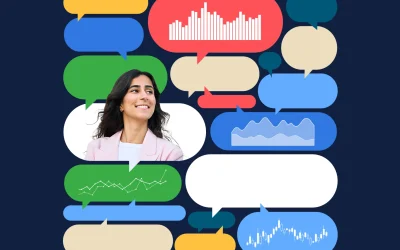Digital marketing, like any discipline, has its own lexicon. If you decide to capitalize on digital services and the competitive edge they provide, it’s important to understand what these marketing terms mean. Below are some of the most commonly used (and most important) marketing terms and phrases in digital marketing.
A/B Testing (or Split Testing)
This form of testing is used to determine which of two variations of a marketing-related item (email, social media ad, website landing page, etc.) has the bigger positive impact on results. Factors as seemingly insignificant as the color of a “Learn More” button can be very important when hundreds or thousands of people will see and react (or not react) to them.
Bounce Rate
This is the percentage of people who visit a website and leave without ever having interacted with it in any way such as clicking a link or button. The lower the bounce rate, the better.
Call-to-Action (CTA)
This term refers to what you want people to do when they see your marketing piece or visit your website. For example, your goal might be for them to contact you, view a video, continue to another webpage, etc.
Click-Through Rate (CTR)
This is the percentage of people who click the link they see in an email or ad, or on a landing page.
Cookie
A cookie is a snippet of computer code that is stored on the device that a person uses to access a website. It is useful to them since it helps the device remember things like what was in their shopping cart for their next visit. Marketers today are required to inform website visitors that they use cookies and ask for permission to place them on the visitor’s device.
Content Marketing
This is a type of marketing in which a relationship is created with potential customers by providing them with valuable information or other resources free of charge and without explicitly promoting the company. For example, an outdoor gear company might offer a free camping checklist that people can use to ensure they don’t forget important items on their trips.
Conversion Rate
This is the rate at which website visitors complete a desired action, such as submitting a form. The higher the conversion rate, the better.
Cost-Per-Click (CPC)
CPC is the amount of money a marketer pays when someone clicks a link in a pay-per-click advertising campaign. It can range from pennies to more than $100 depending on how many other marketers are “bidding” on a particular keyword.
Cost-Per-Impression (CPI or Cost-Per-Thousand/CPM – “M” is the Roman numeral for 1,000)
This is how much an advertiser has agreed to pay for every 1,000 views of their online ad. Using this price structure, a prospect doesn’t have to click the ad, it just has to be displayed to them.
Display Ads
Sometimes called banner ads, display ads are designed to get the attention of website visitors using text, logos, animations, and other graphic elements.
Drip Campaign
A drip campaign is a form of email advertising in which a series of emails is sent to a group of prospects with the goal of building and nurturing a relationship that leads to them becoming a customer.
Email Marketing
This is a form of marketing using emails to engage prospective customers and encourage them to take a particular action (contact the company, download a piece of content, etc.).
Google Analytics
Google Analytics is a free tool from Google that tracks and provides insight on website traffic, conversions, and other metrics important to marketers.
Impression
Used in pay-per-click advertising, an impression is one instance of an ad being shown.
Landing Page
This is a special webpage that is displayed when a person clicks a link in an ad or other digital marketing medium. Typically, it is created for a particular purpose, has content that relates directly to the messaging where the link is found, and is not accessible from the website’s menu system.
Link Building
Link building is a marketing tactic in which high-quality content is created to encourage other websites to create links to the company’s website. These links can help the site achieve a higher ranking with search engines, which can drive more traffic to the site.
Map Pack (also known as Google Snack Pack)
This is the area on a Google search results page that displays information on three businesses listed in the search area. Map pack results are shown when it is clear the searcher is looking for businesses of a particular type in a local area (flower shops in Fort Collins, CO, for example).
On-Page Optimization
This is the process of improving a website’s search ranking by taking actions like adding or improving meta tags on a page or adding content relevant to the page’s purpose and the searcher’s query.
Open Rate
Open rate is the percentage of people who receive an email and open it. The higher the open rate, the better.
Organic Traffic
Organic traffic is the term for website visitors who arrive there by clicking something other than a paid ad. Growing a website’s organic traffic is a way to increase sales without increasing advertising spend.
Pay-Per-Click (PPC)
This is a form of online advertising where advertisers are charged only when someone who views one of their ads clicks a link within the ad. These ads are often displayed in the context of someone using a search engine like Google.
Remarketing (or Retargeting)
This marketing tactic uses cookies placed on a prospective customer’s device when they visit your website to cause your ads to be displayed when they visit other websites. It is designed to help keep your offering top-of-mind as a prospect surfs the web.
SEM (Search Engine Marketing)
This term most commonly refers to a marketing strategy that uses paid ads shown on search engine results pages. Some users expand the definition to mean any digital marketing that involves a search engine.
SEO (Search Engine Optimization)
SEO is the term for steps taken to help a website improve its ranking on search engines. These steps can include publishing relevant content, acquiring more links from respected websites and improving the performance of your website.
UI (User Interface)
This is the part of a website or device that a user interacts with. A good UI can improve the user experience, making it more likely that they will take a desired action, share their experience with other prospects, etc.
UX (User Experience)
UX refers to the quality of a user’s interaction with a company’s website or app. A positive user experience can increase the number of leads captured and sales made and improve word-of-mouth advertising.
Webinar
A webinar is an online seminar used for marketing, training, and other purposes.
Turning Words into Action
Now that you know how to “talk the talk,” we’re happy to help you “walk the walk”! If you have questions about our digital services and how we can assist you in achieving your marketing/sales goals and growing your market share, please contact us at your convenience.


